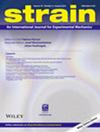The quasi‐static crush response of electron‐beam‐melt Ti6Al4V body‐centred‐cubic lattices: The effect of the number of cells, strut diameter and face sheet
IF 1.8
3区 材料科学
Q2 MATERIALS SCIENCE, CHARACTERIZATION & TESTING
引用次数: 5
Abstract
The effect of the number of cells, strut diameter and face sheet on the compression of electron‐beam‐melt (EBM) Ti6Al4V (Ti64) body‐centred‐cubic (BCC) lattices was investigated experimentally and numerically. The lattices with the same relative density (~0.182) were fabricated with and without 2‐mm‐thick face sheets in 10 and 5 mm cell size, 8–125 unit cell (two to five cells/edge) and 2 and 1 mm strut diameter. The experimental compression tests were further numerically simulated in the LS‐DYNA. Experimentally two bending‐dominated crushing modes, namely, lateral and diagonal layer crushing, were determined. The numerical models however exhibited merely a bending‐dominated lateral layer crushing mode when the erosion strain was 0.4 and without face‐sheet models showed a diagonal layer crushing mode when the erosion strain was 0.3. Lower erosion strains promoted a diagonal layer crushing mode by introducing geometrical inhomogeneity to the lattice, leading to strain localisation as similar to the face sheets which introduced extensive strut bending in the layers adjacent to the face sheets. The face‐sheet model showed a higher but decreasing collapse strength at an increasing number of cells, just as opposite to the without face‐sheet model, and the collapse strength of both models converged when the number of cells was higher than five‐cell/edge. The decrease/increase of the collapse strengths of lattices before the critical number of cells was claimed mainly due to the size‐imposed lattice boundary condition, rather than the specimen volume. The difference in the experimental collapse strengths between the 5‐ and the 10‐mm cell‐size lattices was ascribed to the variations in the microstructures—hence the material model parameters between the small‐diameter and the large‐diameter EBM‐Ti64 strut lattices.电子束熔融Ti6Al4V体心立方晶格的准静态挤压响应:细胞数、支撑直径和面片的影响
采用实验和数值模拟的方法研究了电子束熔体(EBM) Ti6Al4V (Ti64)体心立方(BCC)晶格的压缩情况,研究了胞格数、支撑直径和面片对电子束熔体(EBM) Ti6Al4V (Ti64)体心立方晶格压缩的影响。这些晶格具有相同的相对密度(~0.182),有或没有2毫米厚的面片,细胞尺寸为10和5毫米,8-125单位细胞(2到5个细胞/边),支柱直径为2和1毫米。在LS‐DYNA中进一步对实验压缩试验进行了数值模拟。实验确定了两种弯曲主导的破碎模式,即侧向和对角层破碎。然而,当侵蚀应变为0.4时,数值模型仅显示出弯曲主导的侧向层破碎模式,而当侵蚀应变为0.3时,不含面板的数值模型显示出对角线层破碎模式。较低的侵蚀应变通过引入晶格的几何不均匀性促进了对角线层破碎模式,导致应变局部化类似于面板,在面板相邻的层中引入了广泛的支撑弯曲。与无面板模型相反,当单元格数增加时,面板模型显示出更高但降低的崩溃强度,并且当单元格数大于5个单元/边时,两种模型的崩溃强度收敛。在达到临界细胞数之前,晶格崩溃强度的减小/增加主要是由于尺寸施加的晶格边界条件,而不是样品体积。5 - mm和10 - mm晶格之间的实验坍塌强度差异归因于微观结构的变化,因此小直径和大直径EBM - Ti64支撑晶格之间的材料模型参数也不同。
本文章由计算机程序翻译,如有差异,请以英文原文为准。
求助全文
约1分钟内获得全文
求助全文
来源期刊

Strain
工程技术-材料科学:表征与测试
CiteScore
4.10
自引率
4.80%
发文量
27
期刊介绍:
Strain is an international journal that contains contributions from leading-edge research on the measurement of the mechanical behaviour of structures and systems. Strain only accepts contributions with sufficient novelty in the design, implementation, and/or validation of experimental methodologies to characterize materials, structures, and systems; i.e. contributions that are limited to the application of established methodologies are outside of the scope of the journal. The journal includes papers from all engineering disciplines that deal with material behaviour and degradation under load, structural design and measurement techniques. Although the thrust of the journal is experimental, numerical simulations and validation are included in the coverage.
Strain welcomes papers that deal with novel work in the following areas:
experimental techniques
non-destructive evaluation techniques
numerical analysis, simulation and validation
residual stress measurement techniques
design of composite structures and components
impact behaviour of materials and structures
signal and image processing
transducer and sensor design
structural health monitoring
biomechanics
extreme environment
micro- and nano-scale testing method.
 求助内容:
求助内容: 应助结果提醒方式:
应助结果提醒方式:


